
~~~~~~~~~~~~~~~~~~~~~~~~~~~~~~~~~~~~~~~~~~~
Live Earth Farm (Com)Post
6th Harvest Week, Season 12
May 7th - 13th, 2007
~~~~~~~~~~~~~~~~~~~~~~~~~~~~~~~~~~~~~~~~~~~
(click here for a pdf of the paper
version of this newsletter)
In this issue
--Greetings from Farmer Tom
--Crop Notes
--Family Share "Bonuses"
--How the strawberries work
--More pictures around the farm
--What's in the box this week
--Notes from Debbie's Kitchen
--Calendar
" Whatever you can do or dream you can, begin it.
Boldness has genius, power and magic in it. Begin it now."
~ Goethe
Greetings from Farmer Tom
~~~~~~~~~~~~~~~~~~~~~~~~~~~~~~~~~~~~~~~~~~~~~~~~
Here at the farm we know how important pollination is. Every year in early Spring
when our Warren Pear orchard starts blooming, a small swarm of human pollinators
swing into action. Armed with long dust poles, they puff pollen dust on thousand
of flowers several times over the entire orchard during the annual 10-14 day
blooming period. For some still mysterious reason, this particular pear variety
has poor fruit set when left to its own devices, so to ensure a reasonable harvest,
every year we engage in this cumbersome courtship between us and the pears.
Like most crops we farm, pears typically rely on bees for pollination, and the
most common and favorite bee among farmers for crop pollination is the honeybee.
Everyone is troubled, however, by the recent collapse and disappearance of honeybee
colonies (it is so significant it has been given a name: Colony Collapse Disorder
or CCD). Although nobody knows what's causing it, the threat is being taken seriously
since the losses are quite dramatic all across the United States and Canada,
in Europe, and even as far south as Brazil. Here on the farm we have two beekeepers,
and only one, Greg Muck, believes to have lost one hive to CCD this winter. Steve
Demkowski from Willow Glen apparently didn't lose any of his approximately 10
hives. There is a lot of speculation about the causes of CCD; whether it is from
parasites, fungal diseases, pesticides, poor nutrition, habitat loss, or microwaves
emitted by cell phone towers, nobody knows for sure.

The honeybee is truly one of nature's workhorses. What makes them so popular,
besides the honey they share with us, is that they are able to pollinate a large
number of different plant types. Due to their social nature, they tend to recruit
other bees to visit the same plant several times during their blooming period,
increasing the chances of higher yields of fruit or seeds produced per plant.
Avocados, kiwis, apples, berries, squashes, cucumbers and broccoli are just a
few of the more than 90 fruits and vegetable that depend on bee pollination.
Imagine what the content of our shares would look like if pollination disappears.
If alternative pollinators don't pick up the slack (in pollination loss due to
CCD), we might face a "slow food" diet of bread and water.
As we already know (or should know), too much of a good thing, all the time,
will eventually get you into trouble. So relying solely on one kind of pollinator
for the bulk of the crops in our current food supply is proving to be pretty
risky. Just like it's wise to grow a large diversity of crops to achieve a more
sustainable farming system, we also need to encourage a more diverse population
of pollinators. One way to do this is by increasing the population of native
bees. Supposedly there are more than 3500 species of solitary bees in North America.
Although native bees only make small amounts of honey (which is not collectable),
the sole purpose of attracting them would be for pollination. Native bees can
be divided between soil dwellers and wood dwellers. Soil dwellers include the
bumble and digger bees, and forest dwellers include the mason (or blue orchard),
leafcutter and horned faced bees. The best way to encourage and maintain their
presence is to preserve wild land (habitat), set aside uncultivated areas (undisturbed
hedgerows and field borders) and grow suitable crops to attract and increase
their numbers, making sure to provide sufficient flowering/pollen producing plants
to ‘feed’ them year round, especially through the winter.
Thanks to Steve Demkowski we are starting to introduce native bees into the environment
here at the farm. Steve set us up with nests of mason and leafcutter bees this
spring. These nests seem pretty simple to make; Steve’s design consists
of paper drinking straws about 6” long, capped on the back end, then packed
into an old coffee can which is attached to a post about 5 ft. above ground.
The tubes need to face east, so they get a couple hours of morning sun, and also
need some sort of roof to keep off the rain (and shade them so they don’t
get too much sun and cook!) During our summer solstice celebration in
June, Steve has offered to give a tour of the farm, and introduce interested
members to his hives and shed some light on the importance of both honeybees
and native bees. Maybe we can get him to do a workshop on how to make (and maintain)
your own native bee houses!
Although Einstein has been quoted as saying "without bees, humans will only
have 4 years to live," he probably referred to the popular honeybee and
didn't think of the many native bees, some with pretty cool names such as Shaggy,
Digger, Fuzzyfoot, and Hornface.
Do you ever get this feeling of complete insignificance in the face of all the
news and information we are being bombarded with about the Earth's environment
going to shambles? That the collapse of honeybee colonies are just another example
of a "canary in a coal mine?" It is true that individually we may be
insignificant, however the exciting thing is that everywhere you look a lot of ‘insignificant’ people
are coming together, adding up to a real force of change, creativity, and hope
for the future. I believe in that force and the opportunity it offers for our
children.
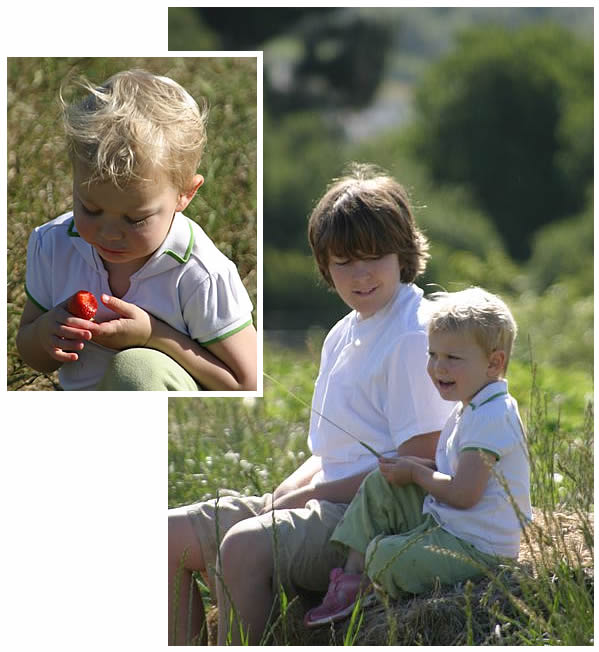
Farmer Tom's children: David and Elisa
Crop Notes
~~~~~~~~~~~~~~~~~~~~~~~~~~~~~~~~~~~~~~~~~~~~~~~~
Throughout May we will mostly be cruising through a lot of the same crops, so
I thought I’d give you a picture of what’s to come. We should have
fava beans for another 3 weeks or so, but then they will be done for the season,
so enjoy them while you can (or if you feel you are getting too many, see Debbie’s
prior newsletters for how to freeze them). The Chinese cabbage and fennel which
I photographed two weeks ago (see Week 4 newsletter) are coming along nicely,
and are probably going to be in your shares in another 2 weeks or so. Things
start to ramp up in June, as the first new red potatoes will be coming in (followed
by yukon gold and yellowfin later in the season); the radicchio should be ready
to harvest sometime in June, maybe even some summer squash, and by the end of
June we should see the first of our green beans. Sometime in July we should have
leeks (I’m leaving them in the ground to get nice and fat). And lastly,
for you ‘Extra Fruit’ members, many of you want to know “when
will it be anything other than strawberries?” That would be sometime in
June, when the plums and blackberries start to ripen (see pictures, below, of
fruit in progress!). And that ‘Strawberry
Bounty’ option? Probably late May.
<back to top>
Family Share "Bonuses"
~~~~~~~~~~~~~~~~~~~~~~~~~~~~~~~~~~~~~~~~~~~~~~~~
Sometimes members find extra goodies in their Family Share boxes which are not
listed under “What’s in the Box.” This is an added bonus to
being a Family Share member, as when we pack the boxes, we always pack the Family
Shares last, so if there is anything we have extra of... you get it! You may
recall there was broccoli in last week’s boxes that wasn’t on the
list. This is an example!
<back to top>
How the strawberries work
~~~~~~~~~~~~~~~~~~~~~~~~~~~~~~~~~~~~~~~~~~~~~~~~
Some members are confused by our system for giving you strawberries, so
I'd like to explain. It is important to understand this so that you don't
ever make assumptions and end up taking the wrong quantity, thereby shorting
other members of their strawberries!
This year there are four
possible ways you can receive strawberries: as a part of your Family
Share, as a part of your Small Share, as a part of your Extra Fruit Option
(if you get this option), or as a part of your "Strawberry Option" (if
you get this option). If you look at the upper right-hand
corner of the checklist in your pickup site binder, it states how many
baskets of strawberries go with each of these four options. The number
of baskets of strawberries next to your name will be the combined total
of berries you get based on your share combination. The checklist is the bible, in terms of quantities
to take; ALWAYS go by what it says on the checklist, as that is how many
baskets of berries we have left at your drop site for you.
The confusion last Wednesday stemmed from my having put only one basket
of strawberries down for the Extra Fruit option instead of two. The quantity
of strawberries left at each site correctly matched the checklist, it
was just the checklist that was wrong! ;-) That's why Wednesday "Extra
Fruit" members are getting 4 instead of 3 baskets this week. - Debbie
<back to top>
More pictures around the farm
~~~~~~~~~~~~~~~~~~~~~~~~~~~~~~~~~~~~~~~~~~~~~~~~
Farmer Tom is enjoying his newly found calling as a photographer, documenting
the farm in pictures! Each week he takes his camera with him into the
fields to capture the essence of what's happening at any one time, or
to illustrate his topic of discussion. Thanks to digital cameras and
the internet, we are able to keep you, our members, even closer in touch
with and up to date on what's happening on 'your' farm!
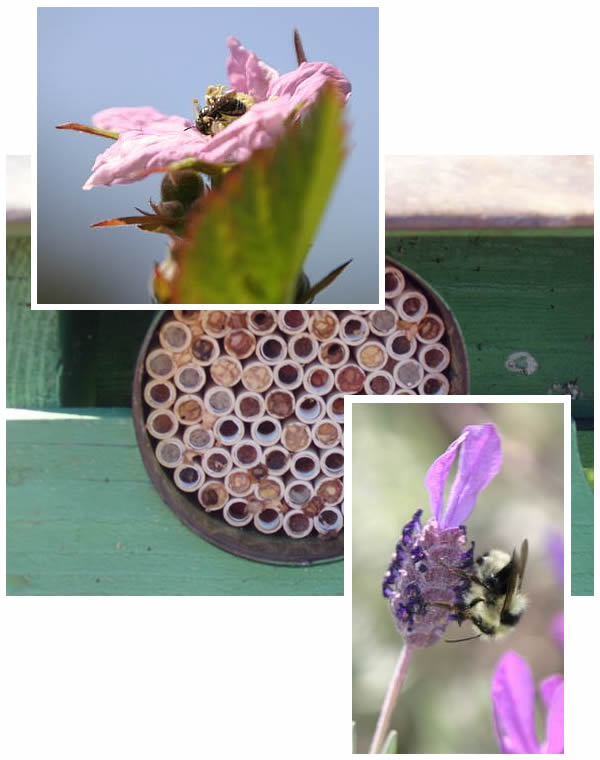
Native bees! At top, a Mason bee (sometimes also called Blue Orchard
Bee, or "BOB" for short) pollinates a blackberry blossom; in
the middle, Steve Demkowski's native bee installation at the farm; and
at lower right, a native bumblebee feasts on a lavender blossom.
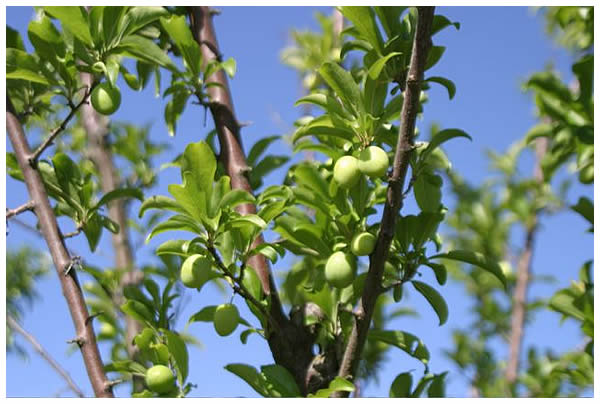
The Santa Rosa plums are sizing up but still green.
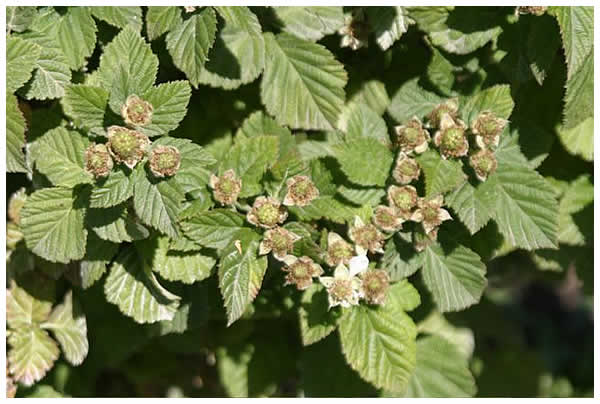 Ditto
for the ollaliberries/blackberries!
Ditto
for the ollaliberries/blackberries!
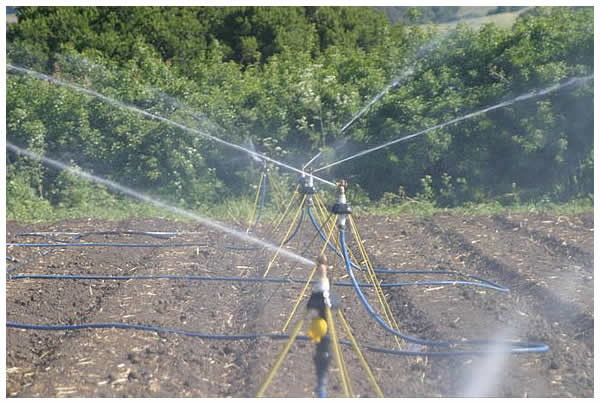
Sprinklers at work on a freshly sown field...
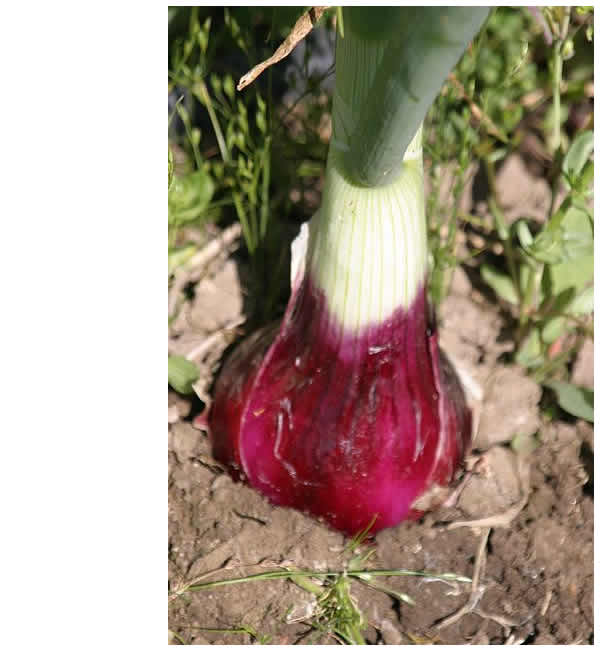 and
a fresh red onion, on the hoof!
and
a fresh red onion, on the hoof!
<back to top>
What's in the box this week
~~~~~~~~~~~~~~~~~~~~~~~~~~~~~~~~~~~~~~~~~~~~~~~~
(Content differences between Family and Small
Shares are underlined and italicized; items with a “+” in
Family Shares are more in quantity than in Small; anticipated quantities are
in parentheses. Sometimes the content of your share will differ from what's on
this list, but we do our best to give you an accurate projection. It's Mother
Nature that throws us the occasional curve ball!)
Family Share:
Red Ace beets
Cauliflower (Lakeside)
Chantenay carrots
Chard
Japanese cucumbers (Nagamini Farm)
Fava beans +
Garlic +
Lettuce +
Mizuna (bagged)
Red mustard greens (bagged)
Onions +
Spinach (Lakeside)
Strawberries (1 basket)
Small Share:
Broccoli (LEF/Lakeside)
Chantenay carrots
Chard
Fava beans
Garlic
Lettuce
Mizuna (bagged)
Red mustard greens (bagged)
Onions
Strawberries (1 bskt)
Extra Fruit Option:
3 baskets of Strawberries
[Wednesday members get 4 baskets to make
up for last week's error!]
Notes from Debbie's Kitchen
~~~~~~~~~~~~~~~~~~~~~~~~~~~~~~~~~~~~~~~~~~~~~~~~
If the recipes I give you here don't suit
your taste, there are literally hundreds more in the recipe database
on our website! There are also many pictures of veggies, in case you
get something in your box you don't recognize. Click
here to go to the recipe database.
- Debbie
Mizuna and Mustard Greens
I’m going to sound like a broken record to longtime members because I usually
give the same advice about both of these greens each year (if you want to see
what they look like, see pictures in the recipe database I mention above;
click on the camera icon to the left of each item’s name in the list).
To prep both greens, dump into a sink of cold water and swish around to release
any possible dirt, then transfer to a salad spinner, separating out and discarding
any yellowed leaves, or the occasional grass or weed. Spin greens well to remove
excess water, then spread out on a cotton dish towel to air dry. Place in a plastic
bag, gently squeeze the air out and refrigerate. If you’re in more of a
hurry, after washing them just roll the greens up, towel and all, and store in
the plastic bag. The towel will wick the water off the greens (you don’t
want to store wet greens in a bag; they rot more quickly that way). It sounds
like a bit of work, but you’ll
be so happy you prepped them this way when, during the week, you can just open
your fridge and they’re ready to go!
How do I use them? I never get beyond using them as a salad green. I love them
this way! Mix them together with torn lettuce, and maybe some spinach, for a
lovely simple green salad with your favorite dressing.
I welcome anyone’s ideas and recipes for cooking either of these greens
if that’s how you like to use them. I expect they’d be good just
simply sautéed in olive oil with a sprinkling of salt and used as a bed
for fish or chicken. They would cook up much like spinach: quickly, and down
to almost nothing in volume when cooked!
Chantenay Carrots
We’re getting a new type of carrot this week, an heirloom variety called
Chantenay (these, alas, I don't have pictures of in the recipe database. Tom,
can you take a shot for me?). They are typically shorter/squattier with broad
shoulders, narrowing quickly to a blunt tip. Sweet, crunchy and carroty, you
can use these any way you’d
use regular carrots.
Five-Minute Beets
from ‘Vegetarian Cooking for Everyone’ and
submitted by member Lauren Thompson via the LEFCSAfriends
yahoo group who says, “If
you are looking for a way to cook beets that is a little less cooking
time intensive, try this out. It takes a little more work in the prep
department, but isn't too bad. The recipe is very flexible."
4 beets, about 1 lb.
1 tablespoon butter
salt and freshly milled pepper
lemon juice or vinegar to taste
2 tablespoons chopped parsley, tarragon, dill, or other herb
Grate the beets into coarse shreds. Melt the butter in a skillet, add the beets,
and toss them with 1/2 teaspoon salt and pepper to taste. Add 1/4 cup
water, then cover the pan and cook over medium heat until the beets are tender.
Remove the lid and raise the heat to boil off any excess water. Taste for salt,
season with a little lemon juice or vinegar-basalmic or red wine is good-and
toss with the herb. If you don't mind the shocking color, you can stir in a
tablespoon of yogurt or sour cream, always a good tasting addition to beets.
Nagamini Farm’s Japanese Cucumbers
Tom put Japanese cucumbers from Nagamini Farm into our shares last year too,
and they are wonderful. Slender and delicate, they do not need to be peeled
or seeded (although you can do both if you prefer, but they're practically
seedless). A nice way to use them is to take a zester and drag it down the
sides of your cukes to create stripes before slicing, or if you don’t
have a zester, simply drag the tines of a fork down the sides of the cucumber
to score its skin and achieve the same effect. They're very pretty when sliced.
Curried Rice and Cucumber Salad
from Farmer John’s Cookbook – the
real dirt on vegetables
Serves 6
“Because they are so mild and refreshing, cucumbers are often used as a
foil to more assertive or fiery ingredients. This recipe pairs juicy cucumber
slices with rich curry seasoning but forgoes the heat, instead letting the freshness
of the cucumber feature prominently. Mixed with golden raisins and tender, aromatic
rice, the result is sweet succulence. Of course, if you like your curry spicy
you can certainly add some hot pepper to this dish, and it will be differently
delicious. You can use vegetable oil or butter instead of ghee, though ghee is
the preferred oil for Indian cooking. You can make this dish up to two days in
advance, store it in the refrigerator, and toss it with freshly toasted nuts
just before serving.”
3 C cooked basmati or jasmine rice
1/3 C sliced scallions [you can use the light green and small inner dark green
stalk and leaves of the onions in your share just as you would scallions]
1/3 C golden raisins
3 tbsp. freshly squeezed lemon juice (about 1 lemon)
salt
½ C coarsely chopped walnuts
1 tbsp. ghee
1 tbsp. curry powder
1 large cucumber, peeled, halved lengthwise, seeds scooped out, thinly sliced
[with Nagamini’s tender little Japanese cucumbers, I wouldn’t bother
to peel or seed them!]
paprika
1. Combine the cooked rice, scallions, raisins, and lemon juice in a large
bowl and stir. Season with salt to taste.
2. Toast the walnuts in a dry, heavy skillet (preferably cast iron) over high
heat until they durn brown in spots and smell fragrant. Transfer nuts to a
dish and set aside to cool. [I like to spread walnuts out on a sheet of foil
and toast them in my toaster oven. Just watch when you do it the first time,
so you don’t burn them. They only take a few minutes to toast.]
3. Quickly wipe the surface of the skillet with a clean towel; melt the ghee
in the skillet over medium heat and stir in the curry powder; stir for 30 seconds.
4. Add the cucumber slices. Cook, stirring constantly, until the cucumber is
tender, 3 to 4 minutes. Remove the skillet from heat.
5. Add the cucumber to the rice mixture and toss to combine. Refrigerate for
at least 1 hour.
6. Toss the toasted walnuts with the salad, then sprinkle a generous amount
of paprika over the top. Serve chilled or at room temperature.
Simple Broccoli and Lemon
I can eat broccoli this way all the time (and often do!): just cut broccoli
into whatever size pieces you like, steam them for 3 to 4 minutes, plate them,
squeeze a goodly amount of fresh lemon juice over them, drizzle with your best
olive oil, and sprinkle with sea salt. The warm broccoli releases the aroma
of the olive oil in a wonderful way! Mmmmmmmm.......
Twice-Baked Sweet Potatoes with Spinach and Coconut Milk
from A Year in a Vegetarian Kitchen, by Jack Bishop
serves 4 as a main course
This recipe was also submitted by Lauren Thompson, who says, “This is
one of my favorite recipes! It's a great way to use up a lot of spinach in
one pass. The flavors of sweet potato and coconut milk together are a must
try!”
4 sweet potatoes (10-11 ounces each), scrubbed
2 tbsp. canola oil, plus more for rubbing on the potatoes
2 tbsp. minced gingerroot
2 tbsp. Thai red curry paste
1 1/4 lbs. flat-leaf spinach, stems removed unless very thin, leaves, washed,
shaken dry to remove excess water, and chopped (about 8 cups)
salt
1/3 C unsweetened coconut milk
3 tbsp. fresh chopped cilantro leaves
1. Move an oven rack to the middle position and heat the oven to 400 degrees.
Lightly rub each potato with a little oil. Place potatoes on a foil lined baking
sheet and bake until the skin is crisp and a skewer slides easily through the
flesh, about 1 hour and 10 minutes. Remove baking sheet from oven and set the
sweet potatoes aside on a rack to cool for 10 minutes. Increase the oven temperature
to 450 degrees.
2. While the sweet potatoes are cooling, heat the 2 tablespoons of oil in a
large saucepan over medium heat until simmering. Add the ginger and the curry
paste and cook until fragrant, about 1 minute. Add the damp spinach, cover,
and cook, stirring once or twice, until completely wilted, about 5 minutes.
Add salt to taste and set the spinach mixture aside.
3. Using a folded kitchen towel to hold the hot sweet potatoes, cut each one
in half lengthwise. (If possible, cut so that the flat side of the sweet potatoes
will rest on the baking sheet.) With a spoon, scoop the flesh from each half
into a medium bowl, leaving a 1/4 inch of the flesh and skin in each shell.
Arrange the empty sweet potato shells on the baking sheet.
4. Mash the sweet potatoes in the bowl with the coconut milk until smooth.
Stir in the spinach mixture and cilantro. Adjust the seasonings, adding salt
to taste.
5. Mound the sweet potato filling into each shell. Bake until the top of the
filling is firm and slightly crisp, about 15 minutes. Remove the baking sheet
from the oven and cool the sweet potatoes on the baking sheet for 5 minutes.
Serve. (Straight from the oven, the potatoes are unbearably hot to eat.)
<back to top>
Calendar of Events
~~~~~~~~~~~~~~~~~~~~~~~~~~~~~~~~~~~~~~~~~~~~~~~~
(see calendar on website for more info)
<> Fri. May 18, Four Fridays Mataganza Garden Internship (5/18, 5/25, 6/1,
6/8)
<>
Sat. Jun 9 Outstanding in the Field Dinner
<> Sat. Jun 23 Summer Solstice
Celebration
<> July 10-14 Teen Adventure Camp
<> Aug 24-26 Childrens Mini-Camp
<>
Sat. Oct 20 Fall Harvest Celebration (in
prior weeks' newsletters this had been mis-dated as October 3rd; it is
October 20th... at 3pm! Thanks to the alert member who caught my error!)
<back to top>
Contact Information
~~~~~~~~~~~~~~~~~~~~~~~~~~~
email the farm: farmers@cruzio.com
email Debbie with newsletter input or recipes: deb@writerguy.com
phone: 831.763.2448
web: http://www.liveearthfarm.net
~~~~~~~~~~~~~~~~~~~~~~~~~~~